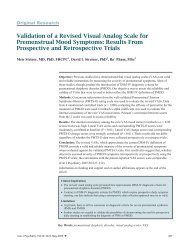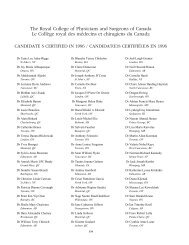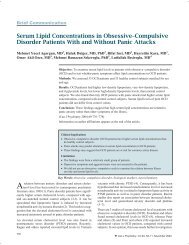The Canadian Journal of Psychiatry - Canadian Psychiatric ...
The Canadian Journal of Psychiatry - Canadian Psychiatric ...
The Canadian Journal of Psychiatry - Canadian Psychiatric ...
You also want an ePaper? Increase the reach of your titles
YUMPU automatically turns print PDFs into web optimized ePapers that Google loves.
<strong>The</strong> <strong>Canadian</strong> <strong>Journal</strong> <strong>of</strong> <strong>Psychiatry</strong>—Original Research<br />
Table 1 Sample characteristics, PANSS syndrome ratings<br />
Schizophrenia group<br />
(n = 32)<br />
Control group<br />
(n = 21)<br />
Age a , mean (SD) 31.8 (9.0) 25.2 (3.2)<br />
Duration <strong>of</strong> illness, a,c mean (SD) 3.3 (5.1) —<br />
ICD-10 diagnosis F20.0 —<br />
n (%)<br />
Sex: male 16 (50.0) 7 (33.3)<br />
Educational level<br />
No degree<br />
1 (3.1)<br />
Elementary school<br />
6 (18.8)<br />
Middle school<br />
9 (28.1)<br />
High school b 16 (50.0)<br />
First-episode patients<br />
Second-episode patients<br />
3 episodes patients<br />
28 (87.5)<br />
3 (9.4)<br />
1 (3.1)<br />
Mean (SD), range<br />
0 (0)<br />
0 (0)<br />
0 (0)<br />
21 (100)<br />
(12 students, 9 clinic staff)<br />
PANSS positive syndrome 2.42 (1.23), 1.00–4.67 —<br />
PANSS negative syndrome 1.87 (0.75), 1.00–3.67 —<br />
PANSS cognitive syndrome 2.18 (0.88), 1.00–4.00 —<br />
PANSS depressive syndrome 2.37 (1.05), 1.00–5.33 —<br />
PANSS excitement syndrome 1.58 (0.45), 1.00–3.00 —<br />
a In years<br />
b Qualifying for entrance to university<br />
c Age at time <strong>of</strong> age at investigation minus age at first prodromal sign<br />
— = no data<br />
—<br />
—<br />
—<br />
exposition). <strong>The</strong> increase had to be greater than the mean<br />
value <strong>of</strong> the preceding baseline plus 2 baseline SDs. A “smile<br />
response” was defined as a reaction <strong>of</strong> the M. zygomaticus<br />
major alone or in combination with a reaction <strong>of</strong> the M. levator<br />
labii and (or) the M. orbicularis oculi.<br />
To calculate changes <strong>of</strong> facial muscle activity, we determined<br />
the difference between mean voltage observed during the trial<br />
and mean voltage observed during baseline.<br />
All statistical analyses were conducted with the Statistical<br />
Package for the Social Sciences (Version 6.1.1, for Macintosh<br />
1999). We tested baseline-to-trial changes <strong>of</strong> muscular activity<br />
(the averaged mean) with paired t tests for both groups and<br />
within the groups for each muscle, separately. We tested<br />
group differences <strong>of</strong> smile response frequencies with<br />
chi-square tests. To examine the relation between facial muscular<br />
reactions and psychopathologic symptoms, we<br />
calculated parametric correlation coefficients (r yx ) for the<br />
patients with schizophrenia.<br />
To test the hypotheses, we accepted P values <strong>of</strong> 0.05, 0.01,<br />
and 0.001 as nominal levels <strong>of</strong> significance, high significance<br />
and very high significance, respectively. Hypothesis testing<br />
was 2-tailed.<br />
Because we wanted to use the original scales <strong>of</strong> the single<br />
PANSS items (rated from 1 = nonexistent to 7 = extreme) for<br />
an interpretation <strong>of</strong> the PANSS syndromes, we calculated the<br />
arithmetic medium instead <strong>of</strong> the sum score when describing<br />
the syndromes. <strong>The</strong> highest means were observed for the POS<br />
and DEP syndromes, respectively; the lowest mean was<br />
observed for the EXC syndrome (Table 1).<br />
Results<br />
Table 2 shows the EMG measurement results from both test<br />
groups. We included 3 facial muscles in this study.<br />
338<br />
Can J <strong>Psychiatry</strong>, Vol 51, No 6, May 2006







